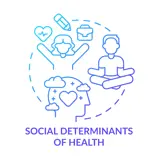Health Action Council believes healthy communities mean a healthier workforce. We recognize the importance a healthy workforce has on an organization.
Using member data, we identify factors contributing to employee health conditions affecting productivity and employers’ profitability. Our value is “connecting the dots”, creating insights, and developing dedicated resources to help employees maintain health and achieve quality outcomes. Our actions improve healthcare and health equity, and mitigate costs on several levels – local, regional, and national.
We catalyze mindsets and practices that enable and optimize cultures centered on health, health equity, and well-being. Our initiatives have direct, real-world impact on the workforce today and in the future. They provide relevant knowledge that improves health literacy and leads to informed decisions. From worksite wellness programming, insights into employer best practices, and turn-key toolkits and programs, members have access to a variety of best-in-class partner programs and services.
These data driven initiatives foster improved consumer health literacy and impact employee and community health:
These additional programs focus on specific emerging health trends identified in member utilization data.

Emergency Room Redirection
The Emergency Room Redirection campaign was designed to educate employees and their communities on how to find the right care setting to save time and avoid costly, unnecessary emergency room visits. Since its launch in 2017, the ER Visits/1000 rate for Health Action Council UHC groups who chose to participate decreased 20%. By comparison, the rate including groups not involved in the annual campaigns increased 9%.

Social Determinant of Health
Today over 40% of members have at least one Social Determinant of Health risk and are 24% more expensive than those without a risk. Health Action Council partnered with United Healthcare to implement a dedicated clinical team and custom clinical model which includes increased engagement with members who have been identified as having clinical and SDoH triggers. The teams include dedicated advocates, nurses, case managers, and social workers. Understanding and addressing these conditions helps improve employee well-being and eliminates the 24% benefits cost differential.

Age Related Health Disparities
Since 2022, Health Action Council has advanced initiatives to address health disparities. It began with Health Action Council realizing its member companies had a high prevalence of hypertension in their populations. A project was launched to reduce costs and the progression of hypertension and improve overall health. In 2023, a campaign was developed for nurses to engage with Generation X women with hypertension and at risk of social isolation. In 2024 the engagement focus became female high utilizers along with women who are at risk for cardiovascular disease with either a food or housing insecurity risk. Within this specific population, the outreach resulted in decreased emergency room visits per 1,000 by over 28 percent and urgent care visits per 1,000 by over 25 percent. Nurse engagement focuses on educating members about their condition, appropriate management through lifestyle changes, diet and exercise, the importance of medication adherence, ongoing monitoring, and connectivity to community-based resources. Nurses engaged with over 1,125 members across these campaigns and closed 621 gaps in care, generating a savings of over $780k or a total estimated PMPM savings of $72.





